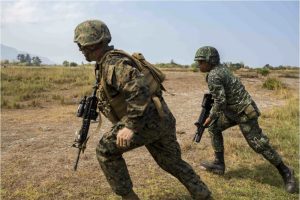In December 2018, Philippine Defense Secretary Delfin Lorenzana declared during a press briefing that the Department of National Defense (DND) was reviewing the 1951 U.S.-Philippines Mutual Defense Treaty (MDT) and its relevance in the 21st century. He said that the time had arrived for the MDT “to be revisited, given that its provisions were formulated in the early 1950s.” Lorenzana explained: “We believe it is time to sit down with our U.S. counterparts and revisit the terms of our alliance. We are partners. We have deep historical ties. We must clearly define our roles and responsibilities when the need arises to be joined in arms.”
The call for a review of the MDT stemmed from Lorenzana’s and the defense establishment’s deep-seated apprehension that the Philippines might be dragged into an armed confrontation between the United States and China. This worry centered on the two powers’ military activities in the South China Sea, namely Chinese construction and fortification of several artificial islands and the U.S. Navy’s repeated freedom of navigation operations and overflights in the disputed waters. There were also anxieties within the DND and the Armed Forces of the Philippines (AFP) about abandonment by their ally, despite promises from U.S. officials that the MDT is an “ironclad” commitment that the United States will honor, even in the contested islands in the South China Sea.
The defense department’s move to subject the MDT to a review was driven by uncertainties over what the U.S. can bring to the table and what it expects from the AFP in case of an armed clash between the U.S. and China in the South China Sea. Lorenzana added that the defense department was assessing if the MDT “should be maintained, strengthened, or scrapped.”
The Philippines and the U.S. signed the MDT on August 30, 1951 in Washington D.C. It linked the Philippine-U.S. alliance to the southern-flank portion of the U.S. regional alliance network – also known as the San Francisco system – which includes the ANZUS pact, a formal defense treaty, entered into in 1951 with Australia and New Zealand. When it was signed, the MDT was never meant to the Philippines’ only bulwark against possible foreign threats that the country might face in the future. The MDT was only one of three security treaties the two allies negotiated and signed as legal instruments for balancing a clearly designated communist-related threat during the Cold War. More significantly, the MDT contains several ambiguous details on how the Philippines and the U.S. will respond to an act of armed aggression committed against either of the two parties.
How did the 1951 MDT became the most important element in the Philippine-U.S. alliance? How have the two allies used the MDT to advance their security interests? And what is the future of MDT, 70 years after it was signed?
































